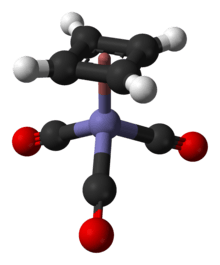Rowland Pettit
Rowland Pettit (February 6, 1927 – December 10, 1981) was an Australian-born American chemist.[1] He was awarded an overseas scholarship from the Royal Commission 1851 from 1952 - 1954. He came to London to Queen Mary College to conduct research into "the molecular orbital theory of organic chemistry and its application". [2] [3] Pettit was noted for preparation of Cyclobutadieneiron tricarbonyl and the related trimethylenemethane complex.[1][3][2] Pettit was head of the Department of Chemistry[1][2] and W. T. Doherty Professor in Chemistry at the University of Texas, Austin,[1][2] a member of the National Academy of Sciences,[1][2][3] a member of the American Chemical Society,[3] a member of the Chemical Society of London,[3] a recipient of the American Chemical Society's the Southwest Regional Award,[3][2][1] a member of the American Academy of Arts and Sciences.[2][3]
The University of Texas said that Pettit was an "internationally recognized organic chemist".[3]

Chronology
- 1927 born in Port Lincoln, Australia[3]
- 1949 B.Sc, University of Adelaide[3]
- 1950 M.Sc, University of Adelaide[3]
- 1953 PhD in chemistry, University of Adelaide[3]
- 1954 2nd PhD, Queen Mary College in London [3]
- 1957 assistant professor, the University of Texas, Austin[3]
- 1960 associate professor, the University of Texas, Austin[3]
- 1963 professor of chemistry, the University of Texas, Austin[3]
- 1968 Southwest Regional Award, the American Chemical Society[3]
- 1970-1974 Chairman of Department of Chemistry, the University of Texas, Austin[3]
- 1973 elected to the National Academy of Sciences[3]
- 1980 advanced to W. T. Doherty Professor in Chemistry, the University of Texas, Austin[3]
- 1981 dies in Austin, Texas
References
- Encyclopedia of Australian Science:Pettit, Rowland
- National Academies Press:Biographical Memoirs:Rowland Pettit; By John C. Gilbert
- University of Texas:In Memoriam:Rowland Petti
- G. F. Emerson, L. Watts, R. Pettit (1965). "Cyclobutadiene- and Benzocyclobutadiene-Iron Tricarbonyl Complexes". J. Am. Chem. Soc. 87: 131–133. doi:10.1021/ja01079a032.CS1 maint: uses authors parameter (link)